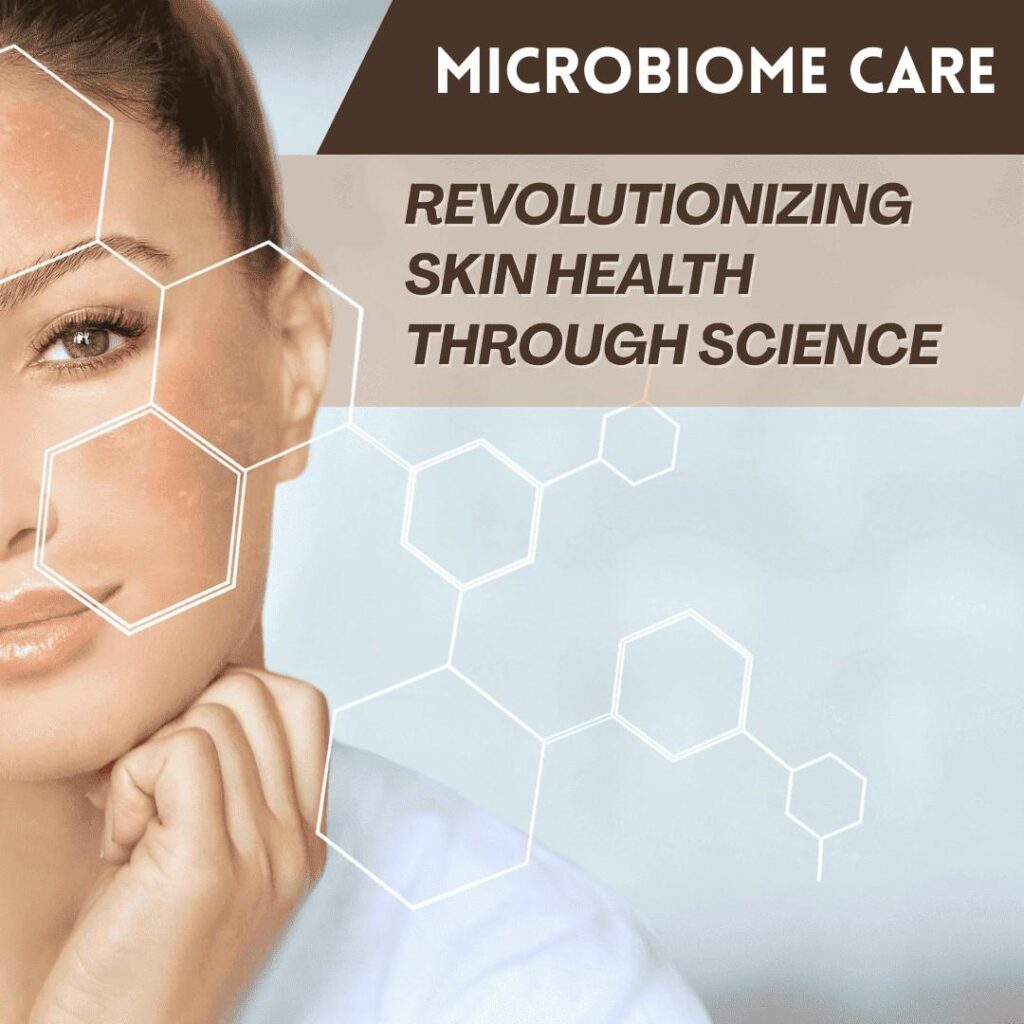The skin microbiome–the collection of microorganisms found on our skin–is essential for skin health and resilience. With recent development in microbiome science, the cosmeceutical industry has been transformed into a new frontier of product offerings to nourish and maintain the fragile dermal ecosystem.
Microbiome Care: Revolutionizing Skin Health through Science
The skin microbiome–the collection of microorganisms found on our skin–is essential for skin health and resilience. With recent development in microbiome science, the cosmeceutical industry has been transformed into a new frontier of product offerings to nourish and maintain the fragile dermal ecosystem.
What is the Skin Microbiome?
A brief synopsis on Skin Microbiome
The skin microbiome refers to the mutually beneficial relationship between fungi, viruses, bacteria and other microorganisms and the human host. The microbial community serves as a biological barrier against pathogen access, impacts immune responses, and influences skin barrier functions.
Functions of the Skin Microbiome
A balanced microbiome contributes to hydration, pH stabilization, and inflammation. The skin microbiome can be altered by skin care or irritant exposure (harsh cleansers, pollution), prescribed medications (antibiotics), and lifestyle factors (diet, stress) creating a disruption in the ecosystem triggering a skin disorder (e.g. acne, psoriasis, eczema, and premature aging).
Health Implications of Microbiome Disruption
The skin microbiome is a dynamic, diverse ecosystem of microorganisms. This system plays a crucial role in maintaining skin health through interactions with skin cells, immune system components, and structural barriers. The skin microbiome is important for homeostasis, health (immune system function), and protection against pathogenic colonization. Dysbiosis in the microbiome has been observed to have an important role in many dermatological problems including acne, eczema, rosacea, and psoriasis. Acne is the most prevalent skin condition globally, affecting around 85% of people at some point in their life, and eczema and psoriasis present major public health challenges creating economic burdens.
Variations in Microbial Communities Across Skin Types
Overall, the microbial communities found in the skin microbiome vary across skin types and anatomical sites (e.g. seborrheic, moist, dry). Different skin types are home to different types of microbial communities. [1]
Table 1: Variations in Microbial Communities Across Different Skin Types
Skin Type | Common Microbial Genera | Characteristics |
Seborrheic | Cutibacterium, Malassezia | Oil-rich, prone to acne |
Moist | Staphylococcus, Corynebacterium | High humidity, found in folds |
Dry | Betaproteobacteria, Flavobacteriales | Low oil, exposed areas, variable flora |
The Importance of Microbiome Care in Skincare
Skincare regimes often tend to focus on cleansing and moisturizing but often ignore one of the most important aspects of skin health, the balance of the skin’s microbiome. Microbiome care is about keeping or getting formulations that stabilize or restore microbial diversity and microbial activity and ultimately treating the underlying cause of skin issues, not just masking it. Microbiome care helps in the following areas:

Microbiome care helps in the following areas:
- Immune Modulation: The microbiome of the skin plays an important role in modulating the immune system. It helps the immune cells differentiate harmless from pathogenic microorganisms which reduces the immune system propensity to react, inaccurate unnecessary inflammation, and allergic reactions. This is especially relevant in cases of eczema, where immune system is overreacting.
- Maintenance of Skin pH: The natural skin pH is acidic (4.5-5.5), which maintenances the skin barrier and protects the viability of the skin microbiome. The microbiome does this by maintaining a healthy pH to deter pathogenic bacteria and promote skin integrity.
- Improved Barrier Function: A healthy skin microbiome will enhance the skin barrier to protect against environmental stressors, pollutants, and allergens, and reduce trans epidermal water loss and microbial invasion due to a compromised skin barrier.
- Reduced Inflammatory Load: A healthy, balanced microbial population allows for a more controlled immune response, with less likelihood for chronic inflammation, redness, and irritation.
- Hydration Improvement: The skin microbiome also aids in moisture retention by activating metabolic activity that supports your skin’s own hydration function.
- Skin Condition Management: Microbiome-targeted therapies may be able to tackle microbial dysbiosis associated with acne, rosacea, dermatitis, and other skin disease by providing a more root-cause approach to therapy. [2]
Elements of Microbiome-Friendly Formulations
Microbiome-friendly cosmeceuticals do not rely upon harsh preservatives, surfactants and synthetic ingredients that can alter microbial populations. These products mainly use active ingredients designed to cultivate the microbiota [2] [3]
Table 2: Key Ingredients in Microbiome-Friendly Cosmeceutical Formulations and Their Roles
| Ingredient Type | Role | Examples |
| Prebiotics | Nourish beneficial microbes | Inulin, Fructooligosaccharides (FOS) |
| Probiotics | Live beneficial microbes to increase microbial diversity and inhibit pathogens | Lactobacillus, Bifidobacterium |
| Postbiotics | Metabolites from probiotics that aid skin barrier repair and immune modulation | Short-chain fatty acids, peptides |
| Polyphenols & Antioxidants | Protect microbes from oxidative stress and inflammation | Green tea extract, resveratrol |
Scientific Advances Driving Microbiome Cosmeceuticals
Recent research shows skin microbiome complexity, and how cosmetic ingredients intersect with it. Innovations in this realm include:
- Targeted Probiotic Strains: Researchers are identifying appropriate bacterial strains that address skin conditions, such as Lactobacillus and Bifidobacterium species.
- Encapsulation Technologies: Protecting probiotics during formulation and when delivering to consumers until applicability or use (at point of sale).
- Metagenomic Profiling: Personalized skincare solutions based on the participants’ microbiome.
- Microbiome-Compatible Preservatives: Formulation approaches to deliver a safe product at its efficacy, while still respecting the microbes. [4] [5]
Ingredients to Avoid in Microbiome-Friendly Cosmeceutical Formulations
Maintaining the delicate balance of the skin microbiome involves carefully selecting ingredients. Certain substances can harm beneficial microbes or disrupt the skin’s natural ecosystem. [6] Below is a short list of ingredients to avoid when formulating skin microbiome care products:
Table 3: Ingredients to Avoid in Microbiome-Friendly Skincare Formulations
Ingredient Category | Examples | Effect on Skin Microbiome |
Harsh Surfactants | Sodium lauryl sulfate (SLS), Sodium laureth sulfate (SLES) | Strip natural oils; disrupt microbial balance |
Synthetic Preservatives | Parabens, formaldehyde releasers, methylisothiazolinone (MIT) | Cause irritation; reduce microbial diversity |
Alcohols | Denatured alcohol, ethanol, isopropyl alcohol | Over-dry skin; alter microbial populations |
Strong Antimicrobials | Benzalkonium chloride, triclosan | Kill both harmful and beneficial bacteria |
High Concentrations of Fragrances & Essential Oils | Tea tree oil, eucalyptus oil | Potentially antimicrobial; disrupt microbiome |
Harsh Acids and Exfoliants | High % AHA/BHA | Alter pH; impact sensitive microbes |
Synthetic Dyes and Colorants | Various synthetic dyes | May cause irritation; indirectly affect microbiome |
Market Trends and Consumer Demand
The global microbiome skincare market is rapidly evolving with a surge in consumer awareness and better demand for scientific evidence-based natural products. According to industry reports, this market sector should see double digit growth over the next five years due to:
- Consumer interest in tailored skincare.
- Consumer preference for clean, sustainable beauty products.
- Consumer demand for effective solutions for sensitive and problem-prone skin.
- Expansion of microbiome research and product development. [7]
Challenges and Future Directions
The global microbiome skincare market is rapidly evolving with a surge in consumer awareness and better demand for scientific evidence-based natural products. According to industry reports, this market sector should see double digit growth over the next five years due to:
- Regulatory Issues: There are regulatory challenges associated with defining live microorganisms in a skincare context.
- Viability and Stability: It is a technical challenge to maintain viable probiotics during transportation and home storage of probiotic skincare.
- Evidence for Claims: More clinical trials will be required to substantiate claims and to develop the best formulations.
Future trends may include:
Conclusion
Microbiome care is a new model that takes skincare beyond the superficial treatment of aesthetics to the targeting, treating, and fostering a healthy skin ecosystem. The beauty and personal care industry can shift towards microbiome-friendly cosmeceutical formulations that are more efficacious, sustainable, and scientifically proven to support consumers’ evolving expectations. For brands and formulators to remain viable participants in a rapidly changing landscape, a concerted focus and investment in microbiome science will be paramount.

Let’s create something Innovative and Delicious together
Food Research Lab strives for excellence in new Food, Beverage and Nutraceutical Product Research and Development by offering cutting edge scientific analysis and expertise.




